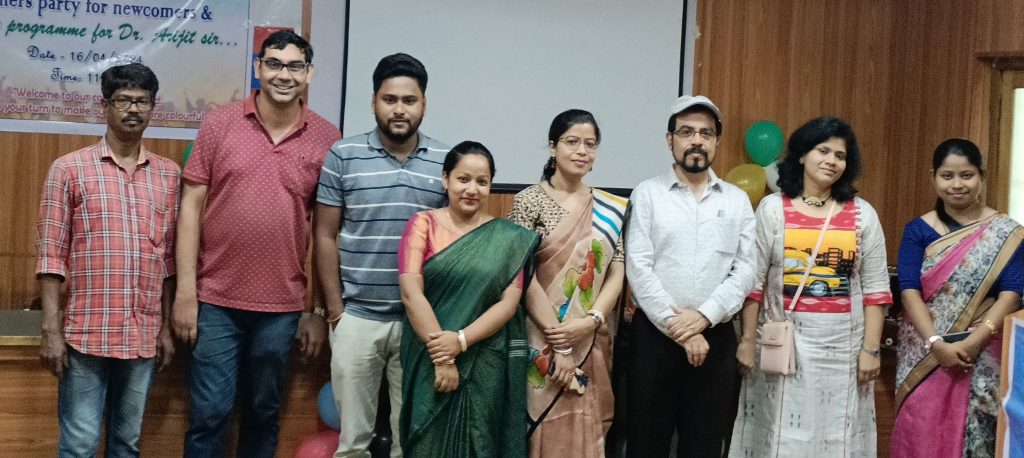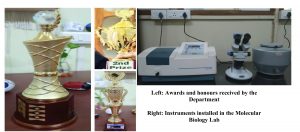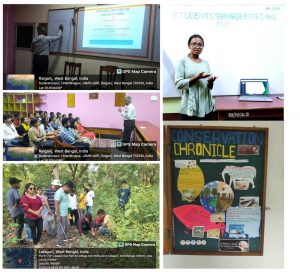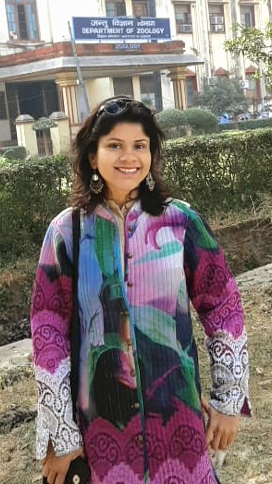ZOOLOGY
- About
- Faculty Profile
- Academic Resource
- Notice
- Publications
- Routine
- Gallery
- Events
** ωειcοmε το δεραrτmεητ οf zοοιοgψ **
Located at the heart of Raiganj Surendranath Mahavidyalaya, our Department of Zoology is a vibrant and dynamic hub for the study of the fascinating world of animals. Our Honours course (initiated from 2008 in addition to previously existing 3-years undergraduate general degree course) has been offering students a comprehensive education in the scientific principles and practices of zoology, preparing them for exciting careers in research, conservation, and beyond.

Faculties and Non-teaching staff of Department of Zoology with our honourable Principal sir
Under the headship of Dr. Priyanjalee Banerjee, a team of experienced and research-oriented faculty members are committed to providing students with a rigorous and engaging learning experience that combines theoretical foundations with hands-on practical skills. Our curriculum is designed to explore the diversity of animal life, from the molecular biology of cells and tissues to the ecology and behavior of complex ecosystems. Whether you’re interested in the biology of life forms, cytogenetics, microbiology, immunology, molecular biology, biochemistry or biotechnology, we offer a range of courses that will challenge and inspire you.
Mission Statement:
The mission of the Department of Zoology is to foster a deeper understanding and appreciation of the biology and diversity of animals, and to equip students with the knowledge, skill, and values necessary to become responsible and informed citizens in a rapidly changing world.

Departmental museum with specimens from various Chordate & Non-chordate phyla

Student Life:
As a student in our department, you’ll have opportunities to participate in fieldwork, laboratory experiments, and research projects that allow you to gain practical experience and develop your skills in areas such as wildlife conservation, animal behavior, evolutionary biology, and more. Our faculties have pursued several research projects that address some of the most pressing disease like neurodegeneration, cancer and bacterial infections. We offer various extracurricular activities and opportunities for students to engage with each other: such as:
- Wall Magazine Club
- Educational tours
- Seminars and Workshops
- Research presentations.

Glimpse of student life
Career Opportunities:
Graduates from our Department can pursue careers in various fields, including:
- Research
- Jobs in Government agencies (mainly, in wildlife conservation, Forest Departments)
- Academia (schools, colleges and universities)

Dr. Priyanjalee Banerjee
Assistant Professor & HEAD OF THE DEPARTMENT
View Profile
Dr. Arijit Pal
Assistant Professor
View Profile
Debajit Chakraborty
SACT
View Profile
Banashree Barman
SACT
View Profile
Tanaya Majumdar
SACT
View Profile
Nandini Das
SACT
View Profile
ZOOLOGY INTERNAL ASSIGNMENT PART -III (HONOURS& GENERAL)
Schedule Internal Exam Sem II AND Sem IV 2021(Hons. & Gen)
Zoology-Sem IV Gen. DC10 Internal Examination 2021
Zoology-Sem II Gen. DC4 Internal Examination 2021
Zoology-SemIV Hons. DC9 Internal Examination 2021
Zoology-SEM IV Hons. DC10 Internal Examination 2021
Zoology-Sem II Hons. DC4 Internal Examination 2021
Zoology -Sem II Hons. DC3 Internal Examination 2021
Zoology-SemIV Hons. DC8 Internal Examination 2021
Zoology-SemIV Gen. SEC 2(Sericulture) Internal Examination 2021
Program Outcomes of B.Sc. in Zoology
:Dr Priyanjalee Banerjee: ________________________________________________________________________________________________ 1. Banerjee P. Breaking New Ground: Leveraging Artificial Intelligence for Precision Medicine in Neurodegeneration. In. Recent Trends in Multidisciplinary Research, 2023, AGAR Publishers, pp 287-313. 2.Bose C, Das U, Kuilya T K, Mondal J, Bhadra J, Banerjee P, Goswami R K, Sinha S. Cananginone Abrogates EMT in Breast Cancer Cells through Hedgehog Signaling. Chemistry and Biodiversity, 2022. 3. Kundu J, Banerjee P, Bose C, Das U, Ghosh U, Sinha S. Internal Oligoguanidinium Transporter: Mercury-Free Scalable Synthesis, Improvement of Cellular Localization, Endosomal Escape, Mitochondrial Localization, and Conjugation with Antisense Morpholino for NANOG Inhibition to Induce Chemosensitization of Taxol in MCF-7 Cells. Bioconjugate Chem. 2020, 31, 10, 2367–82. 4. Bose C, Banerjee P, Kundu J, Dutta B, Ghosh I, et. al. Evaluation of a Tubulin‐Targeted Pyrimidine Indole Hybrid Molecule as an Anticancer Agent, Chemistry Select,2020; 5(44); 14021-31. 5. Ghosh K C, Duttagupta I, Bose C, Banerjee P, Gayen A K, Sinha S. Synthesis and anticancer activities of proline containing cyclic peptides and their linear analogs and congeners. Synthetic Communications, 2019, 49(2), 221-36. 6. Lepeta K, Lourenco M, Schweitzer B, Martino Adami P, Banerjee P, Catuara-Solarz Silvana, de la Fuente Revenga M, Guillem A, Haidar M, Ijomone O, Nadrop B, Qi L, Perera N, Refsgaard L, Reid K, et al..Seidenbecher, Constanze. Synaptopathies: synaptic dysfunction in neurological disorders. Journal of Neurochemistry, 2016 Sep;138(6):785-805. 7. Banerjee P, Sahoo A, Anand S, Bir A, Chakrabarti S. Oral iron chelator, deferasirox, reverses the age dependent alterations in iron and amyloid beta homeostasis in rat brain: implications in the therapy of Alzheimer’s disease.J Alzheimers Dis.2015,2015;49(3):681-93. 8. Kaur U, Banerjee P, Bir A, Sinha M, Biswas A, Chakrabarti S. Reactive Oxygen Species, Redox Signaling and Neuroinflammation in Alzheimer;s Disease: The NF-κB connection. Current Topics in Medicinal Chemistry. 2015;15(5):446-57. 9. Banerjee P, Sahoo A, Anand S, Ganguly A, Righi G, Bovicelli P, Saso L, Chakrabarti S. Multiple mechanisms of iron-induced amyloid beta peptide accumulation in SHSY5Y cells: protective action of negletein. Neuromolecular Medicine, 2014, 16(4), 787-98. 10. Guha Thakurta I, Banerjee P, Bagh MB, Ghosh A, Sahoo A, Chattopadhyay S, Chakrabarti S. Combination of N-Acetylcysteine, α-lipoic acid and α-tocopherol substantially prevents the brain synaptosomal alterations and memory and learning deficits of aged rats. Experimental Gerontology. 2014,50, 19-25. 11. Bandopadhyay K, Banerjee P, Khemka VK, Bir A, Anand S. Lipid peroxidation andantioxidant status in cancer patients: Implications in carcinogenesis. International Journal of Biological and Medical Research, 2014, 5,(1),3755-58. 12. Sahoo A, Banerjee P. NT-ProBNP as a Diagnostic and Prognostic Marker in Case of NSTEMI Patients. Journal of Medical Science and Clinical Research, 2014, 2(8), 2106-13. 13. Sahoo A, Banerjee P. Implications of Procalcitonin as a prognostic marker in neonatal sepsis. International Journal of Science and Research, 2014,3(8), 470-73. 14. Bir A, Sen O, Anand S, Khemka V, Banerjee P, Cappai R, Sahoo A, Chakrabarti S. α-synuclein induced mitochondrial dysfunction in isolated preparation and intact cells: Implications in the pathogenesis of Parkinson’s disease. Journal of Neurochemistry, 2014, 131(6), 868-77. 15. Chakrabarti S, Sinha M, Thakurta IG, Banerjee P, Chattopadhyay M. Oxidative Stress and Amyloid Beta Toxicity in Alzheimer’s Disease: Intervention in a Complex Relationship by Antioxidants. Current Medicinal Chemistry 2013.20(37),4648-64. 16. Banerjee P, Sahoo A, Anand S, Khemka V K, Chakrabarti S. PSS73 - Iron and Oxidative Stress Promote Amyloid Beta Accumulation in Aged Rat Brain and SHSY5Y cells:Therapeutic Implications of Deferasirox in Alzheimer's Disease. Free Radical Biology and Medicine, 2013, 65(2), S43.
:Dr Arijit Pal: ________________________________________________________________________________________________ Research Articles & Reviews: 1. Sharmila L, Pal A, Biswas R, Batabyal K, Dey S, Joardar SN, Dutta TK, Bandyopadhyay S, Pal S, Samanta I. In-silico insights of ESBL variants and tracking the probable sources of ESBL-producing Escherichia coli in a small-scale poultry farm. Microbial Pathogenesis,2024,192: 106710. 2. Ghosh D, Pal A, Raj S, Mahapatra S, Vivekandan P. Distinct epigenetic signatures of classical and hypervirulent Klebsiella pneumoniae. mSphere, 2023,9:00464-23. 3. Das S, Saxena K, Tinguely JC, Pal A, Wickramasinghe N, Khezri A, Dubey V, Ahmad A, Vivekanandan P, Ahmad R, Wadduwage D, Ahluwalia BS; Mehta DS. SERS nanowire chip and machine learning enable instant identification and classification of clinically relevant wild-type and antibiotic resistant bacteria at species and strain level. ACS Applied Materials & Interface, 2023,15:24047-58. 4. Patil D, Sivanandam A, Pal A, Khan WH, Yadav M, Pragya P, Pundir S, Xess I, Mohapatra S, Vivekanandan P, Rao PV. Microtopographic Superhydrophobic Polymer Surface to Prevent Urinary Tract Infections causing Nosocomial Drug-Resistant Bacterial Adhesion. Surfaces and interfaces, 2023, 4:103239. 5. Pal A, Tripathi A. Toxicological and behavioral study of two potential antibacterial agents: 4-chloromercuribenzoic acid and quercetin on Swiss-albino mice. Drug & Chemical Toxicology, 2020, 43(6): 645-55. 6. Pal A, Bhattacharyya I, Tripathi A. Structure-based functional fitness analyses of carbapenemase variants identified among pathogenic carbapenem-resistant Gram-negative bacteria. World Journal of Microbiology & Biotechnology, 2020, 36:129. 7. Pal A, Tripathi A. Demonstration of bactericidal and synergistic activity of quercetin with meropenem among pathogenic carbapenem resistant Escherichia coli and Klebsiella pneumoniae. Microbial Pathogenesis,2020, 143: 104120. 8. Pal A, Tripathi A. Quercetin inhibits carbapenemase and efflux pump activities among carbapenem -resistant Gram-negative bacteria. Acta Pathologica, Microbiologica,et Immunologica Scandinavica, 2020, 128: 251-59. 9. Pal A, Tripathi A. 4-Chloromercuribenzoic acid enhances carbapenem sensitivity among pathogenic Gram negative bacteria by altering blaVIM, adeB and ompC expression. Journal of Infection and Public Health, 2020, 13: 806-814. 10. Pal A, Tripathi A. Quercetin potentiates meropenem activity among pathogenic carbapenem-resistant Pseudomonas aeruginosa and Acinetobacter baumannii. Journal of Applied Microbiology, 2019, 127:1038-47. 11. Pal A, Dhara L, Tripathi A. Contribution of acrB upregulation and OmpC/Ompk36 loss over the presence of blaNDM towards carbapenem resistance development among pathogenic Escherichia coli and Klebsiella spp. Indian Journal Medical Research, 2019; 149(4): 528-38. 12. Pal A, Tripathi A. An in-silico approach to elucidate structure based functional evolution of oxacillinase. Computational Biology and Chemistry, 2016; 64:145-53. 13. Pal A, Tripathi A. An in-silico approach for understanding the molecular evolution of clinically important metallo-beta-lactamases. Infection Genetics and Evolution, 2013; 20: 39-47. 14. Dhara L, Tripathi A, Pal A. Molecular characterization and in-silico analysis of naturally occurring TEM beta-lactamase variants among pathogenic Enterobacteriaceae infecting Indian patients. BioMed Research International, 2013: 1-11. 15. Pal A, Sinha DC, Rastogi NK. Gerris spinolae Lethierry and Severin (Hemiptera: Gerridae)and Brachydeutera longipes Hendel (Diptera: Ephydridae): Two Effective Insect Bioindicators to Monitor Pollution in Some Tropical Freshwater Ponds under Anthropogenic Stress. Psyche, 2012:1-11. Books & Book Chapters: 1. Pal A, & Pal S. Anaerobes. In Extremophiles: Diversity, Adaptation and Applications,2023, Bentham Science Publishers, pp. 275-332.
Class Routine for Semester II & IV MJ & MN 2025-26 Dept. of Zoology
Class Routine for Even Semester Hons. and Gen 2025-26
Departmental ROUTINE ODD SEMESTER 2024-25
College routine ODD Semester (Session 2021-2022), Department of Zoology
Online class routine 2021, Department of Zoology
College routine Even Semester (Session 2022-2023), Department of Zoology
College routine ODD Semester (Session 2023-2024), Department of Zoology
Online class routine 2023, Department of Zoology
Routine for special classes During June 2023, Department of Zoology
Online class routine 2024, Department of Zoology
College routine Even Semester (Session 2023-2024), Department of Zoology
Educational trip to Gorumara-Lataguri National Park 2024
World Environment Day Celebration 2024
Freshers Welcome and Welcome Program of Dr. Arijit Pal 2024
Dr. P. Jha 2nd Memorial lecture 2024
Teachers’ Day Celebration 2024
WildLife week celebration 2023
World Environment Day Celebration 2023
Students’ week Celebration 2023
Teachers’ Day Celebration 2023
World Environment Day Celebration 2022 in collaboration with Nature Club and IQAC
One day trip to Kulik Bird Sanctuary, Local excursion 2022
Educational tour to Padmaja Naidu Zoological Garden, Darjeeling 2023
Dr. P. Jha 1st Memorial Lecture, 2023
National Seminar on World Environment Day 2021 (online Mode)






